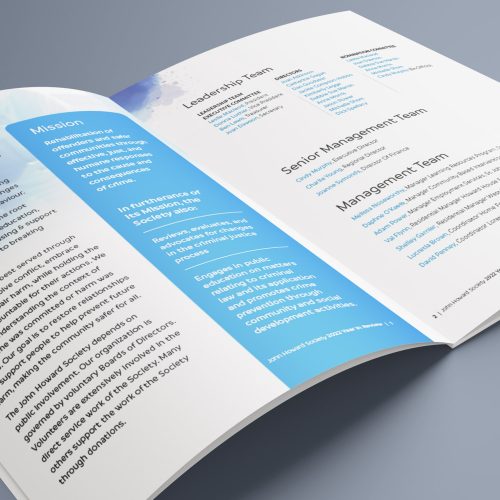Resources
These resources are available from third-parties and sometimes links will break when they update their websites. We will do our best to keep these resource links up-to-date.
Frequently Asked Questions
These are our most commonly asked questions but if you have any other questions not addressed – or addressable – in this FAQ, please feel free to contact us.
The Society is a network of 65 offices across Canada whose mission is to provide various kinds of rehabilitative and reintegrative services to released prisoners; everything from basic job search skills to anger management to life skills to finding affordable housing. If you Google up “John Howard Society” + “your city,” you’ll find the website of the Society office closest to you and a list of programs the office provides.
Various offices across the country provide transitional housing and programs to young persons who are at risk of coming into conflict with the law.
We are a non-profit charity governed by a volunteer board of directors to whom the Executive Director is accountable. Our money flows from various government departments both federally and provincially and we fund raise to finance special projects and programs. You can find two of our recent special projects on our website. The non-profit voluntary sector, also known as the Third Sector, provides a wide range of services on a non-profit basis and employs thousands of people in every aspect of life in Canada, from emergency housing for street children to the management of cultural festivals to the protection of agricultural land.
Many of our front line programs are delivered under contract with Correctional Services of Canada (CSC), the provincial Department of Justice or other provincial Ministries. The programs are open or closed depending on demand, so the list is often changing. The bottom line is that the Society provides services to released prisoners to more effectively re-integrate them into the community after release. We have learned from long experience that re-integration – properly and effectively managed – equates to crime prevention, because if prisoners are humanely and effectively re-integrated into their communities they are less likely to re-offend. Less likely to re-offend means fewer victims of crime. Fewer victims equals safer communities. And that’s good news for everyone.
There’s an organization in the United Kingdom, also founded to fulfill the principles of penal reform articulated by John Howard, called The Howard League for Penal Reform with an excellent website. See also the Howard League for New Zealand.
An English prison reformer who lived from 1726-90. There’s a short bio here and here and another here — and a longer discussion in A Just Measure of Pain: The Penitentiary in the Industrial Revolution 1750-1850 by Michael Ignatieff (Harvard, 1987).
John Howard’s book, for which he became a national celebrity, The State of Prisons in England and Wales, with an Account of some Foreign Prisons (1777) detailed the appalling, cruel, filthy and inhumane conditions he observed in his travels across England, Scotland, Wales and continental Europe.
Here’s a link to a current paper called “How Incarceration Affects Juveniles: A Focus On The Changes In Frequency And Prevalence Of Criminal Activity“ which builds on the work started by John Howard.
They’re still human beings, of course, and that’s one reason to care. But the better reason is that, with few exceptions, almost all get out. And if we know one thing about incarceration it’s this: few people are improved by the experience. On the contrary, some are made worse by their time in prison. At bottom, however, one should care out of simple self-interest: if public safety is important, then we all share a responsibility to humanely and effectively re-integrate former prisoners. We cannot lock up forever everyone who has done something terrible – except for a small minority – so the fact that the majority of prisoners eventually gets out requires us to ask “How might we, as a community, make their return to our community as safe and humane as possible?” – because that’s in our shared interest.
We do. We lock them away and deprive them of the most basic right: to live in society. Punishment would be a lot more satisfying if it worked; if it actually made people better, or improved them in some way. Too often, however, it just hardens their anti-social attitudes. Besides, the threat of being locked away does not seem to deter some people. They don’t calculate the risks of being incarcerated – or the odds of getting caught – the way we might expect them to.
We punish by incarcerating them so that, for a limited period of time, they cannot hurt other people. We try to train them out of the behaviour that brought them to prison in the first place. But that’s not a sure thing because, by the time they get to prison, many of these people are already damaged by;
- Fetal alcohol spectrum disorder and/or bad parenting;
- Impulse control, anger management or emotional problems;
- Inadequate schooling compounded by illiteracy and innumeracy;
- Intellectual deficits or emotional disorders;
- An assortment of untreated and undiagnosed learning disabilities;
- Problems with socialization or undiagnosed/untreated psychiatric and mood disorders like depression, etc.
– this list is quite long.
Some actually do get better in prison: some mature out of their criminal tendencies. You can learn more about fetal alcohol spectrum disorder here.
There is no straightforward answer. It’s very complex and the truth is that many thousands of people with these and worse challenges don’t end up in prison. In fact only a small minority of such people end up in prison. The question of why some people go to jail and others don’t goes right to the heart of how a correctional and justice system works. David Cayley’s The Expanding Prison: The Crisis In Crime & Punishment & The Search For Alternatives (Toronto, 1998) is an excellent introduction to these issues.
And furthermore the question of why some people go to prison, and others don’t has changed through history as the penitentiary’s social and political function has evolved. A Just Measure of Pain tells this story in regard to the history of the industrial revolution. You could make quite a career out of this subject and we can only glimpse the tip of the iceberg in this FAQ. But start here or here.
Three reasons:
- Because all violence is wrong and the state’s use of violence – particularly the taking of a life – is the most wrong of all. John Howard believed, and we think he was right, that all people are capable of correction and improvement if the circumstances are conducive and the will is present.
- Because we might kill the wrong people; like Steven Truscott, Donald Marshall, Guy Paul Morin, David Milgaard and Thomas Sophonow just to draw on recent Canadian history. Capital punishment sentences have even been suspended in a number of US states because there were too many instances of inadequate trials or other miscarriages of due process.
- Nor does capital punishment deter. If it did, Texas would be the safest place in the world.
Once they’re in prison, they’re in the care and custody of the government of Canada. And morality, buttressed by law, requires that they be taken care of at least as well as they would be able to take care of themselves on the outside. Another of John Howard’s insights was that if prisons were allowed to become hothouses of disease, which they were in his time, it would not be possible to contain those diseases to the prisons. So, as a consequence of his reforms, we now take measures to ensure that the public health on the outside is not endangered by the health and living conditions on the inside. Additionally, we know from long experience that brutal conditions breed brutality in incarcerated people. We take the view that prisons ought not brutalize people, that doing so is inhumane and contrary to good public policy which is to model humane behaviour by example. Dental care is provided on an emergency basis, i.e., the removal of teeth. Bridges or dentures are only provided if they are health requirements otherwise a tooth is removed and nothing is replaced. Dental cleaning and preventative care is not completed on essential work. Food meets the requirement of the Canada Food Guide and has been described as “hospital food.”
It’s not cushy. It’s years upon years, in the case of a life sentence, of boredom and idleness coupled to fear and even terror for personal safety. A prison is not a place where prisoners, by and large, feel safe or relaxed. It’s a highly unnatural, often frightening, environment that language cannot adequately capture.
Furthermore, there are different levels of security for the different risks that prisoners represent. Some prisons, like Kingston Pen, are maximum security and have two sections; general custody population and “protective custody” which means that the men there would be at risk of violence in the general population of any other prison. Some are medium security and some are open custody – and sometimes people walk away from these latter facilities. They should not walk away, of course, and they usually return. Visit, if you can, the Penitentiary Museum in Kingston, right across from the Kingston Penitentiary itself.
Few dangerous offenders get out and it’s a long and complex process. They are targets for vigilante justice. Pedophiles, however, do get out when their sentence has expired. But there is good news here, because there’s now evidence that pedophiles are much more treatable than previously thought. This is a complex disorder and a lot of research has been done on it. Be cautious about believing what you read on the Internet – and that applies to everything.
Some internet sources are, obviously, more reliable than others. Generally, anything you get from Statistics Canada or Juristat is pretty reliable. They’ve been checked and validated in numerous ways. If you come across a document on a John Howard Society website, odds are that it’s been sourced from either Juristat or the Department of Justice.
John Howard believed that even people who had done the worst things to others could come to see the error of their ways and turn their lives around – and we share that conviction. So the John Howard workers put their energy into:
- providing programs and services to facilitate the re-integration of offenders, which reduces the incidence of re-offending
- educating the public on the distinction between the “reality of crime” and the “fear of crime,” about which more below
- applying the best evidence of what works to smooth the reintegration of offenders into their communities as participating citizens with a meaningful stake in its well being.
This figure changes every year, but not by a lot. Furthermore, there may be many people in provincial detention centres on remand (awaiting trial) on any given day. The rate of incarceration per 100,000 people has not changed significantly for many years. Canada incarcerates more people than most European countries (approx. 107 per 100,000) and far fewer than the United States (approx. 738 per 100,000) which is a huge change in the past 30 years.
Good question. When a chemical plant dumps poison into a river at night so that it’s washed downstream and diluted in the morning, but the banks of the river are lined with dead fish, is that a crime? For decades the answer was no. Today that kind of activity is called corporate crime, and if it’s part of a pattern of behaviour the plant owners are prosecuted unless they have good friends in government to dismiss the charges.
Is it a crime to dismiss charges against plant owners who dump poisons into rivers and kill fish?
Just that, the fear of crime — anxiety about being the victim of crime or target of a criminal act — is often different from the reality of crime. The two are often not connected: fear of crime may be going up while actual incidents of crime are declining.
Most people don’t realize, for example, that THE MOST DANGEROUS thing any person does in a given day is get into or out of the shower/bathtub or that it’s more dangerous to drive to the next town than to fly around the planet in an Airbus. Did you know that, on a balance of probabilities, you are in more danger from someone you know (wife, husband, sibling, cousin, priest) than from someone you don’t know? That most crimes of violence are committed between people who know each other? – and that most crimes of violence between people who know each other are never reported?
So this too is complex. We know that people who watch a lot of local or dinnertime television news tend to think the world is a more dangerous place than people who read national newspapers (like the Globe and Mail or National Post).
That’s about getting them to use their idle time in a productive way. An evaluation of Adult Basic Education (ABE) in the prison system concluded that “taken together, the results of [these studies] lend new support to the notion that gaining literacy and numeracy skills may be important factors in successful community reintegration.” One of the worst things about being in prison is having nothing productive to do. And a good number of inmates never completed high school, so encouraging them to finish their high school education serves the interests of public safety because it lowers their likelihood of re-offending upon release. That’s good for all of us. If they continue with university courses, so much the better (from a public safety standpoint). We can’t lock them away forever so the better equipped they are to survive and thrive once released, the better for all of us.
Google up your local office, phone the Executive Director and ask about volunteering opportunities. If you have special skills, you might be an excellent candidate for a board member position. We’re always looking to carry our message to more people because we don’t think we have to choose between our values and the evidence of what works: our values accord with the evidence of what works.
Scholarship Available
If you have had contact with the criminal justice system and would like to return to school, you may be eligible to receive the annual Terry M. Carlson Scholarship Award.
For more information, please contact the John Howard Society at info@jhsnl.ca





